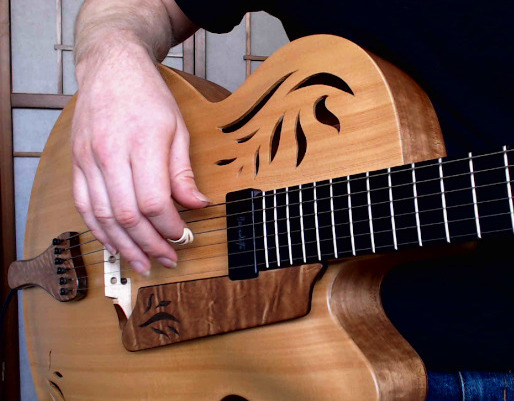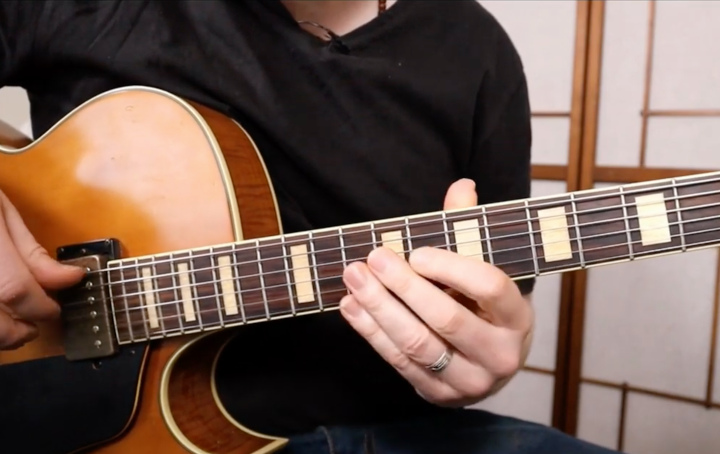
It’s crazy really –
You can have…
- the best ear in the world
- the most sophisticated ideas in your solo
- great rhythm and;
- have a wonderful expressive phrasing
The list goes on.
But:
If you don’t have a good tone (i.e. the quality of the sound your guitar makes), then none of these elements will truly make an impact.
Here’s the good news though:
It’s not that difficult really to get a good sound on your instrument and create a warm jazz guitar tone. Especially these days with so many good quality instruments and amps.
I should let you know though:
You’ll find a whole spectrum of views on the subject of tone.
Some guitarists are ‘gear extremists’, and will proclaim that the quality of your guitar leads has a serious impact on your sound.
Others (and jazz guitarists especially have often been criticized for this) hardly pay attention to tone at all.
Let’s take the ‘middle way’ though – here’s a few tips from a self-proclaimed guitar gear luddite:
Tip #1 – Check with what and how (and where) you are striking the string

I play fingerstyle and use fingernails – so I make sure my nails are polished as smooth as
glass and they have a nice even curve – this has the biggest impact on your sound especially on acoustic instruments. This is one sure way to get a warm jazz guitar tone.
If you are using a plectrum, it should be smooth and of good quality. If your playing sounds too ‘slappy’, try a slightly thicker pick. Resin picks can have a great tone.
Also check where you are plucking the strings – I avoid plucking them too close to the bridge which can sound a bit tinny. Side note: I use 0.12 gauge D’Addario XL Flatwounds for a nice thick sound.
Tip #2 – Quality of your guitar
More expensive does not necessarily equal better tone.
Your guitar needs to be decent – however the make and model isn’t as important as you might think.
Make sure the action is set appropriately so the strings don’t buzz on the frets. Also check the strings aren’t old.
(Reason: old strings will sound out of tune as you go up the neck).
Whichever instrument you play, choose a guitar of which you enjoy the sound and feel.
More expensive does not necessarily equal better tone – when I picked up my first archtop I tried every one in the store, and the Ibanez you see me playing on my videos was a MUCH better tone than guitars at four times the price.
Tip #3 – Tone Knob (especially for jazz!)
Regardless of instrument, if you are playing jazz and want the typical jazz tone, roll your tone knob down quite a bit (I do this even on my archtop) and as I mentioned before, play more towards the neck pickup rather than the bridge – you’ll get that warm, ‘sweet as chocolate sound’. Ooooh yeah.
Tip #4 – Your amp (if using an electric guitar)
Here’s the thing:
A good quality amp is actually more important than the guitar when it comes to tone. For jazz, a valve amp can definitely give a great sound, however these days I’m using a Boss Katana solid state amp and get a fantastic result.
Tip #5 – Experiment!
There is no universal ‘good tone’. Experiment with the above and come up with a sound YOU are happy with.
There is no universal ‘good tone’. Experiment with the above and come up with a sound YOU are happy with.
Tone is a very subjective thing, and there is no one right way.
My approach:
Experiment with all the above factors until you settle on a sound which best serves to deliver your musical message, and go with your gut.
Then, record yourself and listen back and evaluate your tone. Rinse and repeat a few times until you pin down a suitable tone.
Be careful though:
Embarking on a quest for the ‘perfect tone’ can be quite a rabbit hole to go down. Near enough is usually good enough – spend a bit of time finding your sound but then turn your attention to the most important bit – actually playing music!
Over to you – what did YOU think of this article on getting a good jazz guitar tone? Leave a comment below with your thoughts.
Greg O’Rourke
Founder, FretDojo
World Leader in Online Guitar Education


I use the flesh of my fingers near the active single coil neck pickup with the guitar tone knob and the amplifier equality knobs set to five with a touch of reverb and compression to achieve a warm tone with all strings equal in clarity. The Fender Mustang LT25 has a Jazz Amp preset that emulates an electric guitar going directly into a mixing board. This is a perfect complement to my Fender Stratocaster.
Hi
Thanks for the helpful tip on how to get a warm jazz sound
That’s a very wide range… I like my sound on a Fender Deluxe, a Henriksen or (no joke) on an Ampeg cl micro. In compare I get crazy to find a winner but it’s like spice in a meal. The spring of my Deluxe is totaly different to a digital reverb but the “bassamps” are smoother and warmer – in my ear!
The most important point: feel good during playing and enjoy! If the amp don’t let jou feel the right way, it’s the wrong one.
Thanks for this post!
I use 335 Ibanez clone. Roland jc40. Thomastik bebop strings 12. I often get compliments from other players. Strings are expensive but wonderful
It’s been so many years since I played regularly that my technical knowledge of string composition and gauges is out of date. What I remember clearly is on my hollow body circa 1961 Epiphone Broadway I found the thickest flat-wound strings provided the mellow tone I was looking for. Finding the right combination of equipment while considering the personal method of playing is usually only discovered with time and experimentation.
Two more tricks for you:
1. I use D’Addario flatwound 11gauge but put a 13 gauge string on the top to give a thicker tone.
2. I use a Jim Dunlop ‘big stubby’ 3mm pick but I don’t use the pointy end. I pluck the strings with one of the rounded corners instead (someone once told me that this was a Pat Metheney trick). Try it -it makes a huge difference.
I get more comments about my lovely tone than I do about my playing!!
All helpful tips. Thanks Greg. I’ve never used a resin guitar pick — where can you buy them?
Confused on rolling down tone knob do you mean for less bass sound ?? Thanks Ken
Great Article !!! Not just for Jazz but I think these steps can be applied to all forms of music.
How about doing a video on this so we can hear the difference
Thanks for that spot on info Greg . . .
I have tried various ways, but finally use either flat wounds and fingers,
or the Big Stubby on it’s side . . . sounds good.
Cheers
From my perspective it would be helpful to have a bit more discussion regards basic amp settings such as treble, mid and bass, reverb and (maybe gain).
Hi Stephen, Great suggestion, perhaps we can have a mini lesson on this in the future! Generally, Greg uses no effects on the amp and rolls the tone knob all the way down to get that thick sound. (from Sara, Admin in the FretDojo Academy)
I’d love to see the setup for his katana; mine just frustrates me!
I often wonder why amp controls are never mentioned. Archtop guitars seem to need more in the mids to get that round smooth tone. Also larger gage treble strings help dampen the high end. Show the amps and their settings plus examples 8f you want to teach anything.
You do all the above & it sounds great then you go out on a gig & on stage it sounds completely different, that’s jazz
It helps to have a starting point on the amp settings. Freddie Green used 0,5,0 for his bass, mid, tbl respectively. With a little experimenting on my crate telluride I have found 2,5,3 seems to work great (I have no tone pot on my guitar).
A good starting point for most amps is 5,5,5 and then fiddle with it from there.
There was a recent study with strings (these were 5 fusion guys) who determined that for their style 10 gauge round wounds were best.
Part of the mystique of heavy gauge strings comes from the Charlie Christian era when guitars were poorly amped and had to cut through a big band. In this case the heavier the strings, the louder the guitar (as a luthier and physicist I could go into detail why, but not here). Though with modern setups heavier strings will interact better with the pickup magnet. My strings are D’Addario jazz lights (11 gauge)
I find I get the best tone on all my electric archtop guitars using a Dunlop 208 pick and Thomastik-Infeld 12 or 13 gauge flatwound strings – JS112 or JS113. Anything less that a 12 gauge just doesn’t work for me. For acoustic archtops, I’m currently using Newtone Strings Master Class 13 gauge. I have various amps, always on a clean setting, but always use an alnico speaker e.g. Jensen P12N, Celestion Alnico Blue or Alnico Gold.
Good advice, Greg! Will just add that my all-time favourite jazz strings are Thomastik flatwounds, heavy gauge (13-56). Warm, stable, long-lasting.
Usually, we underestimate importance of a pick (if you use it). For a little money you can get a big result.
Recently I started to use Ibanez EL4ST22 Elastomer Triangle pick 2.2 Soft. It is a winner.
I agree with your hints. However, I notice you mentioned 0.012 flatwounds I have just bought my first pack of flatwounds – really nice, and no string squeak. The 3rd, 4th, 5th and 6th strings are definitely wound but I don’t think the 1st and 2nd are wound. They are D’addario. Can I purchase 1st and 2nd flatwounds and if so, how do they sound? My preference is .012” and 0.016”.
Many thanks for your super emails and hope to hear from you.
David Price
Can I buy flat wound stings for 1st and 2nd strings?